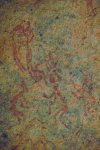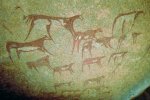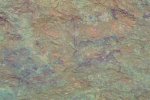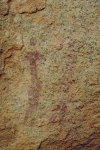

Western Uweinat rock art sites
The western, granitic part of Uweinat lying in present day Libya contains a number of major sites, ranking among the most important prehistoric paintings. The Ain Doua paintings, discovered by Almásy and Di Caporiacco in 1933 were the first major site to be discovered in the region, that bought about a rush of exploration in the following years revealing a multitude of new sites. Strangely, aside Ain Doua the early explorers found nothing in the major western Karkurs, it was only in April 1961 that Bellini & Arié discovered the large shelter near the entrance of Karkur Idriss. This amazing site contains over 700 (!) figures on the ceiling of a shelter formed by an enormous granite boulder. Further discoveries were made by Le Quellec in 1996, and ourselves in 2001. A thorough survey of the area is planned during the forthcoming expedition in the autumn of 2003.
Ain Doua
The first paintings were discovered in the spring of 1933 by Almásy and di Caporiacco, both of whom later claimed the discovery solely for themselves, and entered into a heated dispute (made more colorful by Leo Frobenius, who was guided to the place by Almásy a year later, and subsequently presented the discoveries as his). Reconstructing the various accounts, it seems that if anyone, Almásy's Sudanese driver, Sabr should take the credit, as apparently he noticed the paintings first. Today the site is in a rather sad state. The spring is still in use by the drivers and passengers of the truck convoys going between El Fasher and Kufra, and the lower lying areas are full of rubish and refuse of every imaginable nature. The lower lying sites are much faded and damaged, but happily the most important shelters, lying 10-20 metres above the spring level, are almost intact.
Bu Helega
Near the confluence of Karkur Hamid and Karkur Idriss, there is a very picturesque hill made up of enormous rounded granite boulders (like a large pile of potatoes, as some have commented). There are four sites around it, including the famous large shelter.

|
The first site, reported by le Quellec, is near the northern end. It contains a curious group of embracing and dancing (?) figures, plus a group of inevitable bovids. |

|
The second site, also found by le Quellec not far from the first, contains a beautifully preserved scene of bovids, as if painted yesterday. It contains a unique scene of a cow giving birth. |
The large shelter is a short distance to the south of the previous ones. It consists of a fairly large open space under a huge granite boulder. The ceiling of the shelter is covered with paintings over an area of at least 15-20 square metres, making it to my knowledge the largest single scene painted in prehistory. The figures are mainly cattle, but there are a several groups of apparently dancing human figures in the very peculiar Karnasahi style known from the central Tibesti. During their 1968 visit, a member of the Belgian expedition went to the trouble of counting the number of individual figures, and came up with the 700 number. (Anyone wishing to go back to verify ? ;))
The fourth site at Bu Helega is just a little beyond the large shelter, on a vertical exposed rock face. It contains strange "roundhead" figures unlike any other at Uweinat or the Gilf area. They bear a strong resemblance to the roundhead paintings of the Tassili N'Ajjer.
Karkur Idriss
Further up Karkur Idriss there are four sites in two groups. The first site is located around the sides of a very large isolated granite boulder, first noted by the belgian expedition in 1968.

|
A short distance from the large boulder, we found in 2001 a faint scene under a low shelter. |
Some distance beyond the previous site, in a shelter some 10 metres above the valley floor, we found in 2001 an interesting scene with archers and curious figures apparently wearing skirts (?).

|
Near the upper end of the valley, on a vertical face of an isolated granite block, there is a scene with dancing figures in a very unusual style. This site was discovered by Le Quellec in 1996. |
Karkur Ibrahim
Le Quellec during his short visit found four new sites in Karkur Ibrahim, that was declared void of any paintings by Rhotert. During our visit in 2001, we have managed to locate two of these. One is a very interesting shelter with a well preserved large group of cattle and humans, including a scene with four calves tethered to a tree.

|
The other site nearby contains some faint human figures, possibly of the "roundhead" type. |
During our ascent of the peak in 2001, we have come accross a small shelter in the upper reaches of Karkur Ibrahim (also called Wadi Abd el Melik), at an altitude of about 800 metres (200 metres above the main wadi floor). There are some faint figures on the outside, and very bright red figures in a little hollow in the shelter itself. The female figure is unlike any other noted at Uweinat, it bears some resemblance to certain roundhead type figures in the Tassili N'Ajjer.
"Lost" Sites
Paolo Graziosi in his "Rock Art in the Libyan Sahara" (Firenze, 1962) published two photos, taken by Dr Angelo Pesce (figs. 69 & 70). The captions place them somewhere in Karkur Idriss, but no further explanation or discussion given. Judging the style, both paintings are definitely at Uweinat. The first photo is very similar in style to the large shelter at Karkur Idriss, but it is certainly not a part of it (unless it has disappeared since). The second is more like the sites at Ain Doua. I have not seen these, or seen any other reference to them, they remain a mystery.
If anybody has any information, please contact me !

|

|

|